The U.S. labor market is still struggling to recover from the effects of the Great Recession. The recession officially lasted from December 2007 to June 2009,10 but the national unemployment rate continued to rise, peaking at 9.6% annually in 2010. Employment is recovering slowly, with the level in 2011 still 6 million fewer than the level in 2007.11 The long shelf life of the economic downturn has pressed upon the economic well-being of virtually all workers, with the youngest adults (ages 18 to 24) among those most affected.12
 In the past decade—and especially since 2007—young adults (ages 18 to 24) have faced a difficult job market. The unemployment rate for young adults is almost double the overall rate. Over the past two years a smaller share of the young adult population has been employed than at any time since 1948, the first year these data became available, and a growing share has left the labor market. Moreover, the Great Recession had a more severe impact on the earnings of young adults than on those of any other age group.
In the past decade—and especially since 2007—young adults (ages 18 to 24) have faced a difficult job market. The unemployment rate for young adults is almost double the overall rate. Over the past two years a smaller share of the young adult population has been employed than at any time since 1948, the first year these data became available, and a growing share has left the labor market. Moreover, the Great Recession had a more severe impact on the earnings of young adults than on those of any other age group.
Adults ages 25 to 34 have also encountered a tough labor market in the past decade. However, the recession did not harm their employment prospects or affect their earnings as much as it did for the youngest adults. Overall, trends in employment and earnings for adults ages 25 to 34 have approximated the trends for the broader workforce.
This chapter reports on labor market outcomes for young adults and other workers grouped by age. The focus is on trends for people ages 18 to 64 over the past two decades and on the changes wrought by the Great Recession. We omit 16- and 17-year-olds and people 65 and older from the analysis because of their limited engagement with the labor market.13
The Unemployment Rate
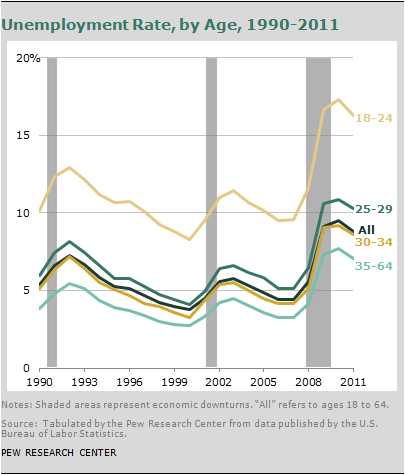 In 2011, the unemployment rate among 18- to 24-year-olds was 16.3%. That was six percentage points higher than the rate for 25- to 29-year-olds (10.3%) and nearly eight points higher than the rate for those ages 3o to 34 (8.6%). The unemployment rate comprises workers who are not currently working but are actively looking for work as a share of the total labor force: those with a job or actively looking for one. Overall, the unemployment rate for 18- to 64-year-olds was 8.8% in 2011.
In 2011, the unemployment rate among 18- to 24-year-olds was 16.3%. That was six percentage points higher than the rate for 25- to 29-year-olds (10.3%) and nearly eight points higher than the rate for those ages 3o to 34 (8.6%). The unemployment rate comprises workers who are not currently working but are actively looking for work as a share of the total labor force: those with a job or actively looking for one. Overall, the unemployment rate for 18- to 64-year-olds was 8.8% in 2011.
Unemployment rates for all age groups rise and fall with the business cycle in similar fashion. It is clear, however, that the youngest adults are set apart from other age groups with consistently high unemployment rates. In the past two decades, through three recessions and a record-long period of economic growth, the unemployment rate for 18- to 24-year-olds was typically four percentage points or more higher than the rate for 25- to 29-year-olds. It was higher still in comparison with other age groups. For most age groups, unemployment rates peaked in 2010 at the highest levels since 1948.14
The Employment Rate
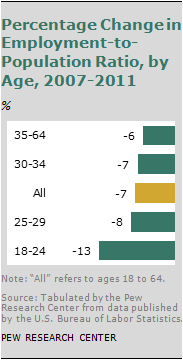 The employment rate, also known as the employment-to-population ratio, is the share of the working age population (ages 16 and older) that is working. During the Great Recession, the employment rate for young adults fell more than for any other age group. Just over half of 18- to 24-year-olds (54.3%) were employed in 2011, compared with 62.4% in 2007, a 13% decrease.15 The current employment rate, along with a nearly identical one in 2010 (54.0%), marked the lowest employment-to-population ratio for young adults since 1948.16
The employment rate, also known as the employment-to-population ratio, is the share of the working age population (ages 16 and older) that is working. During the Great Recession, the employment rate for young adults fell more than for any other age group. Just over half of 18- to 24-year-olds (54.3%) were employed in 2011, compared with 62.4% in 2007, a 13% decrease.15 The current employment rate, along with a nearly identical one in 2010 (54.0%), marked the lowest employment-to-population ratio for young adults since 1948.16
The employment rate is a general indicator of the labor market’s job-creating capacity. Other age groups also experienced declines in their employment rates with the onset of the recession, but not as much as the decline for young adults. From 2007 to 2011, the employment rate of 25- to 29-year-olds fell 8% and the employment rate of 30- to 34-year-olds fell 7%. The employment rate of 35- to 64-year-olds decreased by 6% during that period.17
The relatively sharp decline in the employment rate for 18- to 24-year-olds predates the recession. From 2000 to 2007, their employment rate fell from 67.3% to 62.4%, a 7% drop. That decrease again was much higher than the decrease for any other age group.
An increase in high school and college enrollment is one reason that fewer young adults are on the job today. In 2011, 45.2% of 18- to 24-year-olds were enrolled in high school or college—a large increase from 1990, when only about three-in-ten young adults (31.3%) were pursuing education. Since students are less likely to seek employment than adults who are not in school, some of the employment rate decline among young adults reflects their increased pursuit of formal schooling.
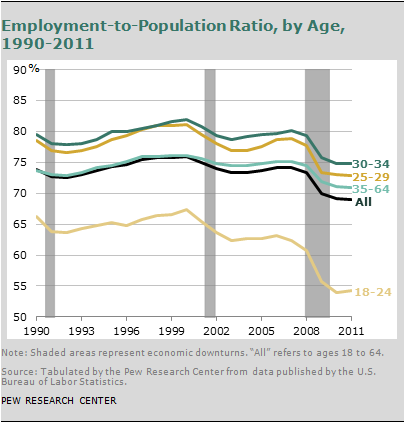 But the Great Recession broadly reduced the employment rate of young adults regardless of whether they were in school. The share of 18- to 24-year-olds enrolled in high school or college
But the Great Recession broadly reduced the employment rate of young adults regardless of whether they were in school. The share of 18- to 24-year-olds enrolled in high school or college
who were employed dropped from 47.6% in 2007 to 40.7% in 2011. 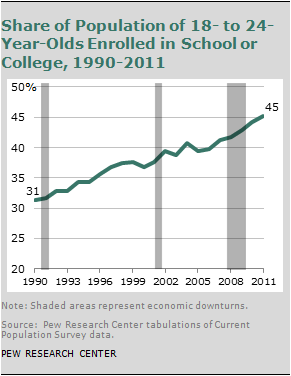 Among young adults not enrolled in high school or college, the employment rate fell from 73.2% in 2007 to 65.0% in 2011.
Among young adults not enrolled in high school or college, the employment rate fell from 73.2% in 2007 to 65.0% in 2011. 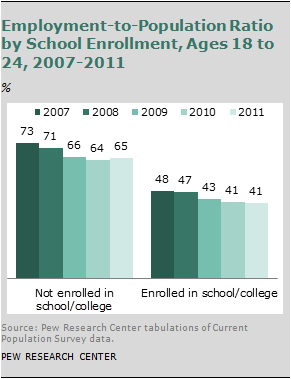 Thus, there was an across-the-board decrease in the employment rate of young adults, a trend that was given a further push downward with the increased enrollment of young adults in educational institutions.
Thus, there was an across-the-board decrease in the employment rate of young adults, a trend that was given a further push downward with the increased enrollment of young adults in educational institutions.
Labor Force Participation
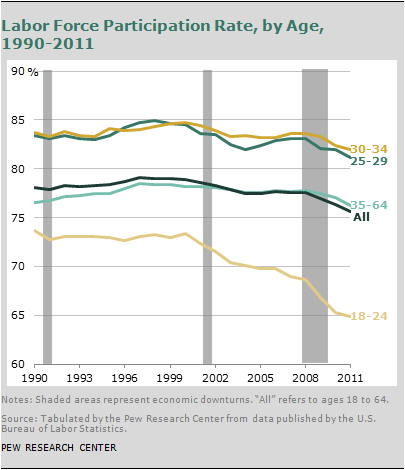 The labor force, an indicator of the supply of workers, includes people on the job or actively looking for one. Labor force participation tends to rise with emerging job opportunities during economic expansions and to fall with waning employment prospects during recessions.
The labor force, an indicator of the supply of workers, includes people on the job or actively looking for one. Labor force participation tends to rise with emerging job opportunities during economic expansions and to fall with waning employment prospects during recessions.
Young adults, many of whom are enrolled in school or college, generally participate in the labor force at a lower rate than adults 25 and older. Partly driven by the ongoing rise in school enrollments, the labor supply of 18- to 24-year-olds fell more than any other age group during the Great Recession.
The labor force participation rate among young adults shrank from 69.0% in 2007 to 64.9% in 2011, a decrease of 6%. The drop in labor participation for 25- to 29-year-olds was more modest, from 83.1% in 2007 to 81.1% in 2011. For 30- to 34-year-olds, the labor force participation rate decreased from 83.6% to 81.9% during this period.
Weekly Earnings
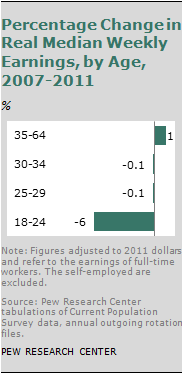 The Great Recession harmed not only the employment prospects of workers, but also their paycheck. Young adults, who are typically at the start of their career and earnings ladder, also experienced the greatest drop in weekly earnings as a result of the recession. It is possible that employers constrained the wages of entry-level jobs more than they did for other jobs during the recession.
The Great Recession harmed not only the employment prospects of workers, but also their paycheck. Young adults, who are typically at the start of their career and earnings ladder, also experienced the greatest drop in weekly earnings as a result of the recession. It is possible that employers constrained the wages of entry-level jobs more than they did for other jobs during the recession.
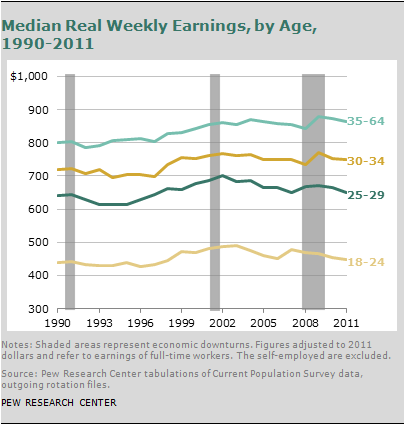 In 2011, the median weekly earnings of 18- to 24-year-olds who worked full time were $448. That figure was 6.1% less than their median earnings of $477 in 2007. Workers ages 25 to 29 and ages 30 to 34 experienced no change in their wages. For 25- to 29-year-olds who worked full time, median weekly earnings were $651 in 2007 and $650 in 2011. The earnings of 30- to 34-year-olds were $751 in 2007 and $750 in 2011. (All earnings figures are expressed in 2011 dollars.)
In 2011, the median weekly earnings of 18- to 24-year-olds who worked full time were $448. That figure was 6.1% less than their median earnings of $477 in 2007. Workers ages 25 to 29 and ages 30 to 34 experienced no change in their wages. For 25- to 29-year-olds who worked full time, median weekly earnings were $651 in 2007 and $650 in 2011. The earnings of 30- to 34-year-olds were $751 in 2007 and $750 in 2011. (All earnings figures are expressed in 2011 dollars.)


